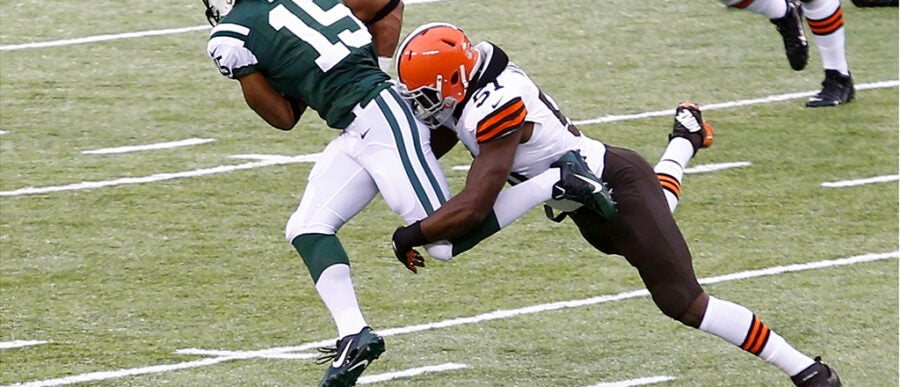Scott Rosner, a Wharton professor of legal studies and business ethics, and faculty advisor to the Wharton Sports Business Initiative, joined Paul H. Haagen, a professor at Duke University’s School of Law and co-director of its Center for Sports Law and Policy, to discuss the recent TV ratings decline for National Football League games. They looked at what is behind the decline and how sports leagues could engage better with viewers on the Knowledge at Wharton show, part of Wharton Business Radio on SiriusXM channel 111. (Listen to the podcast at the top of this page.)
Here are five takeaways from their discussion:
Ratings Down Across the Board:
Although the National Football League (NFL) has seen its TV viewership ratings fall 12% between the 2015 and 2016 seasons, it is not alone. The English Premier League (EPL) has had it worse, notes Haagen, and Rosner adds Canada’s National Hockey League to that list. Sky Sports has seen a 19% year-on-year drop in its EPL ratings this season, according to the Daily Mail, while NHL ratings are down 11% thus far this season, says The Toronto Star. In Canada, the fact that no Canadian teams featured in the playoffs – the first time in 40 years – could be one big reason, says Rosner. “It is possible we are seeing worldwide a shift in viewership patterns [of] anything that is long-form viewership,” says Haagen, adding that “it is hard to explain why it is happening so sharply.”
Why the Ratings are Down?
Public engagement with the U.S. presidential election was one reason for the drop in the NFL’s ratings, says Rosner. TV viewership ratings for the news-focused political shows are up by roughly the same amount the NFL viewership is down, he explains.
Another factor at work could be “a mean regression” or “a little bit of a correction,” from the 26% growth in ratings for NFL games between 2008 and 2015, says Rosner. He recalls that between 2008 and 2015, “the story lines at NFL had been fantastic,” compared to now. Other than the emergence of the quarterback Tom Brady at the New England Patriots, there hasn’t been a dynamic team that you would want to focus attention on.”
The 2007-2008 economic recession also ran parallel with the earlier boom times for NFL ratings, says Rosner. Fantasy sports also helped boost ratings in that period. “We watch more and we watch for longer if you have money riding on the game or if your fantasy team is heavily engaged in it.”
“It is possible we are seeing worldwide a shift in viewership patterns [of] anything that is long-form viewership … it is hard to explain why it is happening so sharply.” –Paul H. Haagen
Viewers may also have “hit the saturation point” with the proliferation of games on TV, says Rosner, and notes that the just-ended World Series baseball games also clashed with the timings of the NFL games. Other reasons he cites includes the growth of cord-cutting, where people cancel cable TV subscription plans to watch programs online at places like Netflix, broadcasts on Twitter thanks to the latter’s deal with NFL, and the increasing length of the NFL games that may tire out viewer
Haagen wonders if a long-term trend is at play here. “The worry is whether sports in general has gotten to a saturation point, where it really can’t operate in a way that it has done for at least the last two decades of bringing together an entire demographic, the entire country around a series of events”
Caution to Advertisers — Hold It
Advertisers are probably closely watching NFL’s ratings dive, but are unlikely to have any sudden reactions because they typically have long-term deals with the NFL, says Rosner. In any event, advertisers don’t have too many options, says Haagen. He points to media reports that talk of ratings declines for NASCAR races and college sports as well. “There is betting going on that there aren’t other effective options for the advertisers.”
Rosner urges ad buyers to exercise some patience. “This [NFL] is still the best property in terms of reaching mass audiences, especially the 18- to 49-year-old demographic that you could get. It would be foolhardy to change course right now.” He also notes that sports are considered DVR-proof and “it has to be consumed live, which means more to the advertisers.”
Retaining Viewer Loyalties:
Noting that ratings are down across the board, Haagen points to the role of social channels like Twitter as important in determining future directions. “We may be seeing a lot of experimentation trying to hold that younger demographic in the viewership market,” he says. “Overwhelmingly, younger people now do not subscribe to cable and do not watch television — they are on other kinds of screens. Sports is going to have to look at different modes of delivery, different pricing structures or they are going to lose an audience.”
“This [NFL] is still the best property in terms of reaching mass audiences, especially the 18- to 49-year-old demographic” –Scott Rosner
Rosner agrees that experimentation on how best to retain viewers must be the new name of the game. “The ability for any one sports event to amass a large audience should decrease because there are a lot more viewing options.” However, Rosner believes the NFL and other sports have compelling content. “People are still going to want to watch that content, although they may watch it in different ways as new technologies come into play,” he says. “The trick now in the long term is to figure out a monetization strategy for it.”
Lifting the Ratings Back Up
Notwithstanding the ratings declines, Rosner says that the Sunday late afternoon window is “extremely valuable,” adding that “CBS and Fox pay a tremendous amount of money to the NFL for the right to broadcast their games.” Oftentimes that window out-rates even Sunday night football on NBC, even though it is not a prime-time audience, he notes.
The NFL games may have turned away some fans because they have been less competitive than in earlier seasons and they have lacked sufficient star power, says Rosner. “All you would need is some great games and you would get your mojo back,” He adds. “That goes back to the idea that this is more of a blip than it is anything like a long term trend.”



